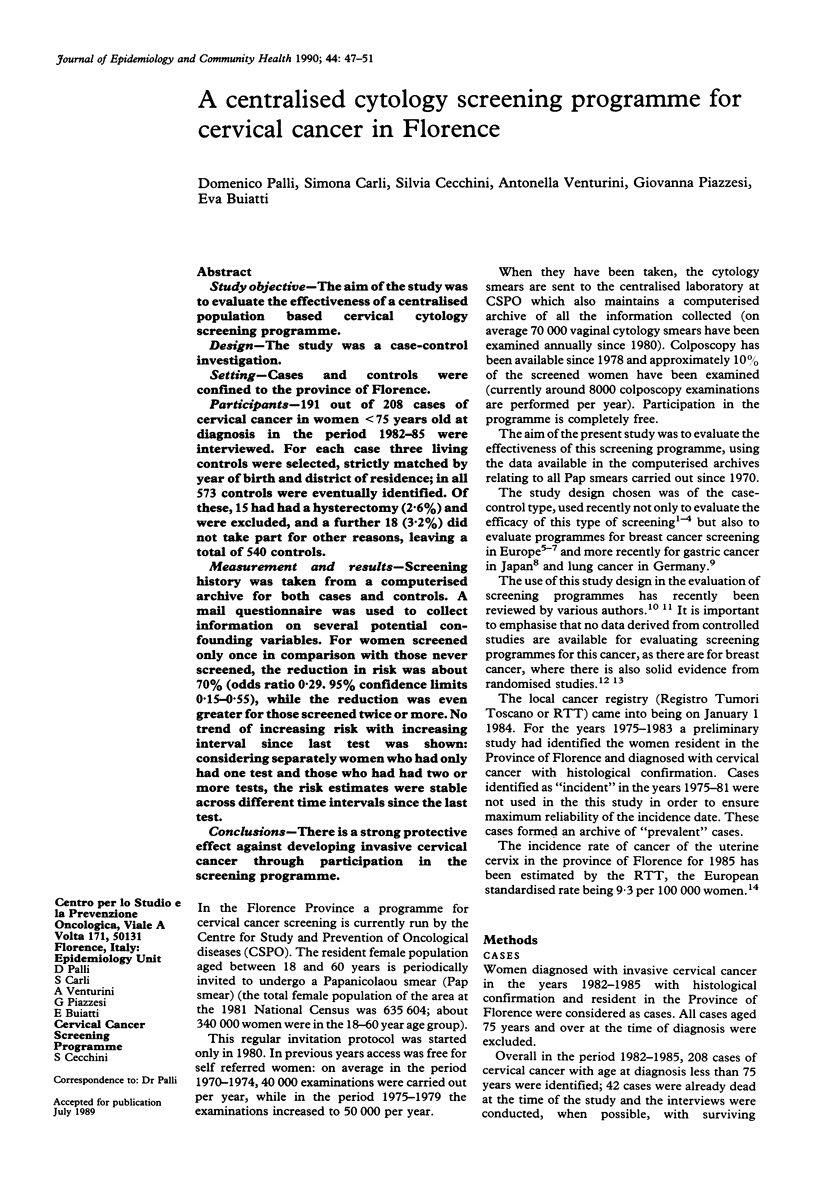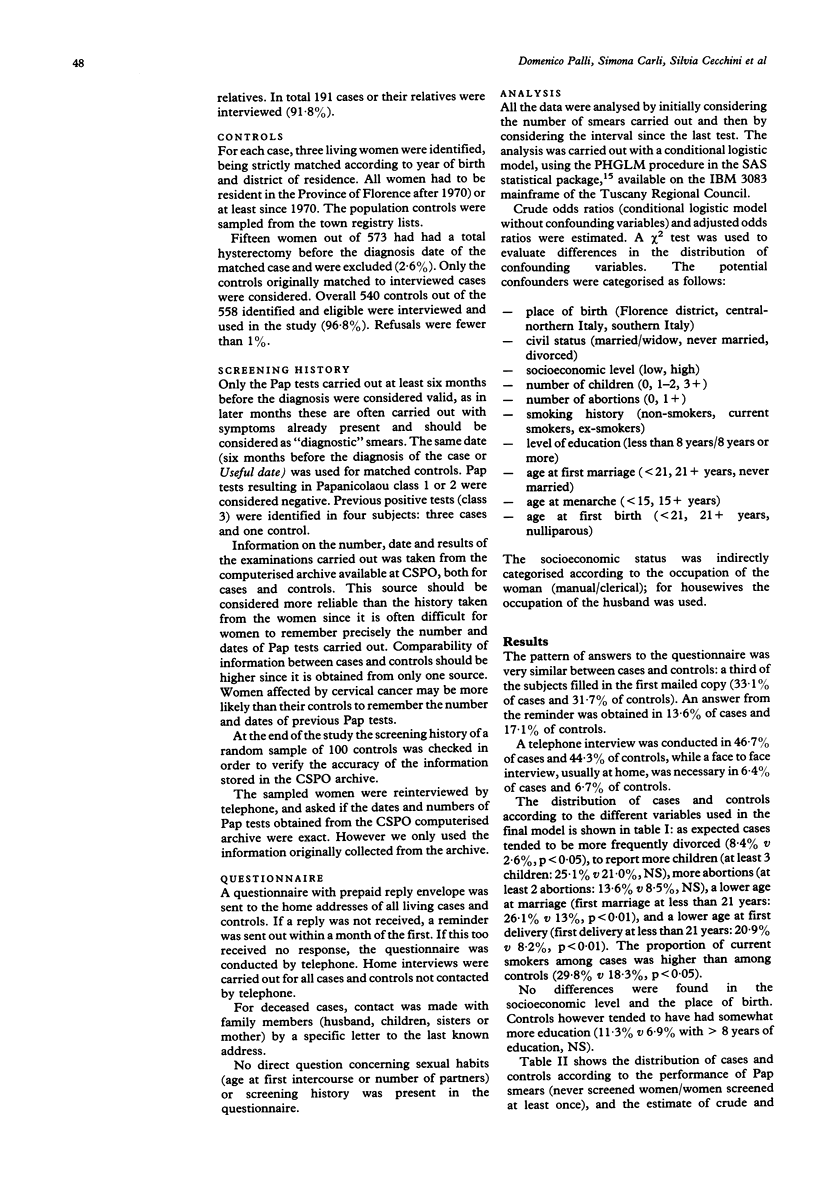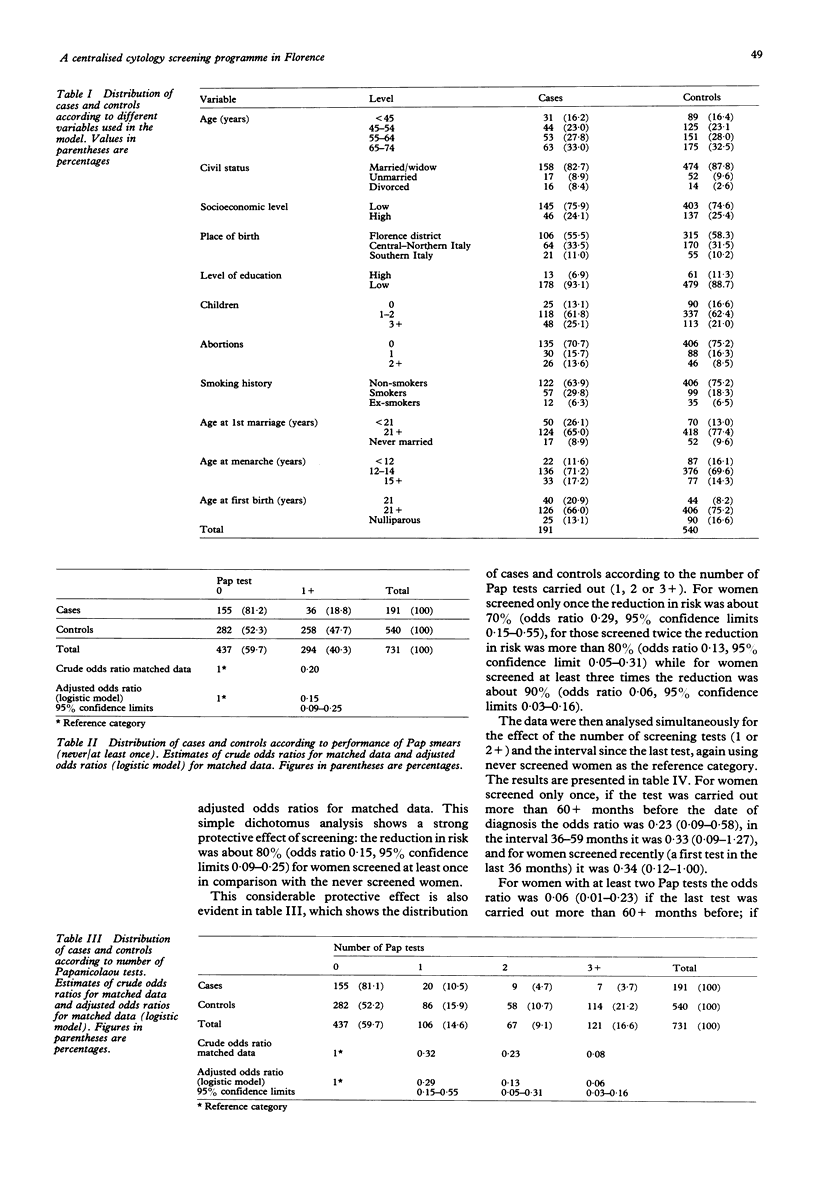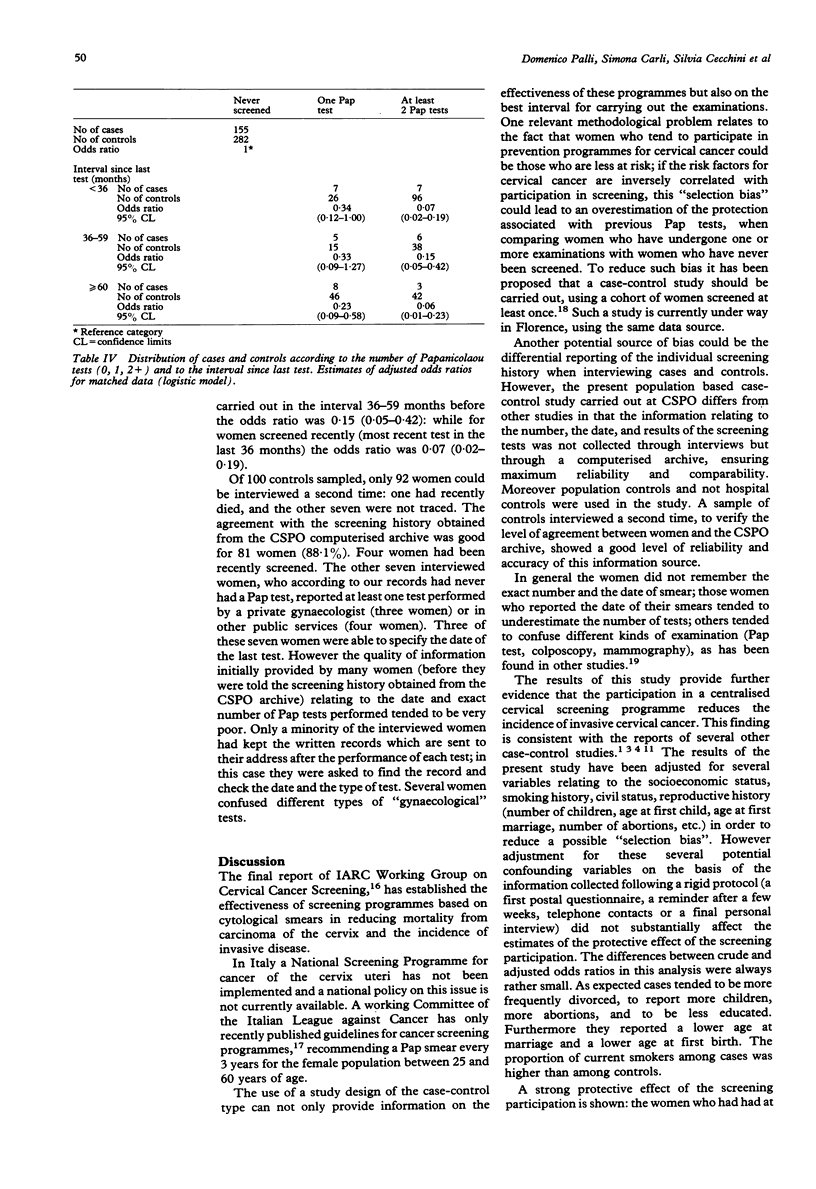Abstract
STUDY OBJECTIVE--The aim of the study was to evaluate the effectiveness of a centralised population based cervical cytology screening programme. DESIGN--The study was a case-control investigation. SETTING--Cases and controls were confined to the province of Florence. PARTICIPANTS--191 out of 208 cases of cervical cancer in women less than 75 years old at diagnosis in the period 1982-85 were interviewed. For each case three living controls were selected, strictly matched by year of birth and district of residence; in all 573 controls were eventually identified. Of these, 15 had had a hysterectomy (2.6%) and were excluded, and a further 18 (3.2%) did not take part for other reasons, leaving a total of 540 controls. MEASUREMENT AND RESULTS--Screening history was taken from a computerised archive for both cases and controls. A mail questionnaire was used to collect information on several potential confounding variables. For women screened only once in comparison with those never screened, the reduction in risk was about 70% (odds ratio 0.29. 95% confidence limits 0.15-0.55), while the reduction was even greater for those screened twice or more. No trend of increasing risk with increasing interval since last test was shown: considering separately women who had only had one test and those who had had two or more tests, the risk estimates were stable across different time intervals since the last test. CONCLUSIONS--There is a strong protective effect against developing invasive cervical cancer through participation in the screening programme.
Full text
PDF




Selected References
These references are in PubMed. This may not be the complete list of references from this article.
- Aristizabal N., Cuello C., Correa P., Collazos T., Haenszel W. The impact of vaginal cytology on cervical cancer risks in Cali, Colombia. Int J Cancer. 1984 Jul 15;34(1):5–9. doi: 10.1002/ijc.2910340103. [DOI] [PubMed] [Google Scholar]
- Clarke E. A., Anderson T. W. Does screening by "Pap" smears help prevent cervical cancer? A case-control study. Lancet. 1979 Jul 7;2(8132):1–4. doi: 10.1016/s0140-6736(79)90172-7. [DOI] [PubMed] [Google Scholar]
- Collette H. J., Day N. E., Rombach J. J., de Waard F. Evaluation of screening for breast cancer in a non-randomised study (the DOM project) by means of a case-control study. Lancet. 1984 Jun 2;1(8388):1224–1226. doi: 10.1016/s0140-6736(84)91704-5. [DOI] [PubMed] [Google Scholar]
- Day N. E. Effect of cervical cancer screening in Scandinavia. Obstet Gynecol. 1984 May;63(5):714–718. [PubMed] [Google Scholar]
- Ebeling K., Nischan P. Screening for lung cancer--results from a case-control study. Int J Cancer. 1987 Aug 15;40(2):141–144. doi: 10.1002/ijc.2910400202. [DOI] [PubMed] [Google Scholar]
- La Vecchia C., Franceschi S., Decarli A., Fasoli M., Gentile A., Tognoni G. "Pap" smear and the risk of cervical neoplasia: quantitative estimates from a case-control study. Lancet. 1984 Oct 6;2(8406):779–782. doi: 10.1016/s0140-6736(84)90705-0. [DOI] [PubMed] [Google Scholar]
- Lynge E., Poll P. Incidence of cervical cancer following negative smear. A cohort study from Maribo County, Denmark. Am J Epidemiol. 1986 Sep;124(3):345–352. doi: 10.1093/oxfordjournals.aje.a114404. [DOI] [PubMed] [Google Scholar]
- Macgregor J. E., Moss S. M., Parkin D. M., Day N. E. A case-control study of cervical cancer screening in north east Scotland. Br Med J (Clin Res Ed) 1985 May 25;290(6481):1543–1546. doi: 10.1136/bmj.290.6481.1543. [DOI] [PMC free article] [PubMed] [Google Scholar]
- Oshima A., Hirata N., Ubukata T., Umeda K., Fujimoto I. Evaluation of a mass screening program for stomach cancer with a case-control study design. Int J Cancer. 1986 Dec 15;38(6):829–833. doi: 10.1002/ijc.2910380608. [DOI] [PubMed] [Google Scholar]
- Palli D., Del Turco M. R., Buiatti E., Carli S., Ciatto S., Toscani L., Maltoni G. A case-control study of the efficacy of a non-randomized breast cancer screening program in Florence (Italy). Int J Cancer. 1986 Oct 15;38(4):501–504. doi: 10.1002/ijc.2910380408. [DOI] [PubMed] [Google Scholar]
- Sasco A. J., Day N. E., Walter S. D. Case-control studies for the evaluation of screening. J Chronic Dis. 1986;39(5):399–405. doi: 10.1016/0021-9681(86)90126-8. [DOI] [PubMed] [Google Scholar]
- Shapiro S., Venet W., Strax P., Venet L., Roeser R. Ten- to fourteen-year effect of screening on breast cancer mortality. J Natl Cancer Inst. 1982 Aug;69(2):349–355. [PubMed] [Google Scholar]
- Singer A., Walker P., Tay S. K., Dyson J. Impact of introduction of colposcopy to a district general hospital. Br Med J (Clin Res Ed) 1984 Oct 20;289(6451):1049–1051. doi: 10.1136/bmj.289.6451.1049. [DOI] [PMC free article] [PubMed] [Google Scholar]
- Tabár L., Fagerberg C. J., Gad A., Baldetorp L., Holmberg L. H., Gröntoft O., Ljungquist U., Lundström B., Månson J. C., Eklund G. Reduction in mortality from breast cancer after mass screening with mammography. Randomised trial from the Breast Cancer Screening Working Group of the Swedish National Board of Health and Welfare. Lancet. 1985 Apr 13;1(8433):829–832. doi: 10.1016/s0140-6736(85)92204-4. [DOI] [PubMed] [Google Scholar]
- Verbeek A. L., Hendriks J. H., Holland R., Mravunac M., Sturmans F., Day N. E. Reduction of breast cancer mortality through mass screening with modern mammography. First results of the Nijmegen project, 1975-1981. Lancet. 1984 Jun 2;1(8388):1222–1224. doi: 10.1016/s0140-6736(84)91703-3. [DOI] [PubMed] [Google Scholar]
- Walter S. D., Clarke E. A., Hatcher J., Stitt L. W. A comparison of physician and patient reports of Pap smear histories. J Clin Epidemiol. 1988;41(4):401–410. doi: 10.1016/0895-4356(88)90148-5. [DOI] [PubMed] [Google Scholar]


